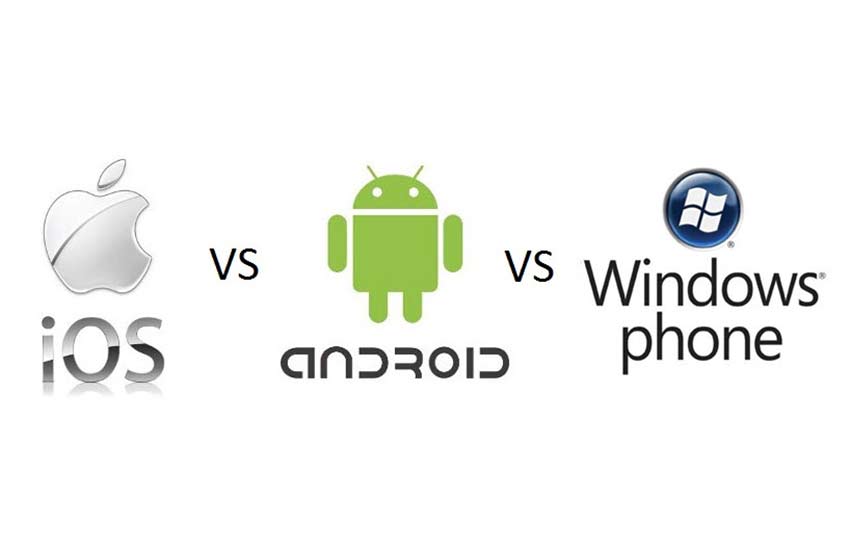Each developer has to focus on several factors to make his mobile app successful and profitable. In addition to concentrating on the app’s look, feel, features and performance, he also needs to target the right mobile platform. But the choice of mobile operating systems differs from one programmer to another. Some developers prefer building apps for the most popular mobile operating system, whereas others target multiple mobile operating systems.

In terms of worldwide market share, iOS, Android, and Windows Phone are the three most popular mobile operating systems of 2015. However, there is a huge difference in the worldwide market share of each mobile platform. Likewise, the feature’s functionality of each mobile operating system also differs from others. That is why; it becomes essential for mobile app developers to understand some of the most important differences between iOS, Android, and Windows Phone.
IOS vs. Android vs. Windows Phone
History
Apple introduced iPhone OS in June 2008. In June 2010, Apple renamed iPhone OS like iOS and made the mobile operating system support iPhone, iPad, and iPod Touch. Google released the first commercial version of Android in September 2008. Microsoft launched Windows Phone in October 2010. So Windows Phone is comparatively younger than the other two mobile platforms. However, the three mobile operating systems are being updated regularly. Apple, Google, and Microsoft have already made pre-release beta versions of iOS 9, Android M, and Windows 10 Mobile to programmers.
Worldwide Market Share
As a long list of reports has highlighted, Android is currently the most popular mobile operating system in the market. According to the latest data published by the International Data Company (IDC), Android dominates the worldwide mobile OS market with a share of 78%. On the other hand, Apple’s worldwide mobile OS market share is 18.3%, and Windows Phone’s is 2.7%. The popularity and market share of each mobile OS keep fluctuating. But Android still has a much higher worldwide market share than both Android and Windows Phone.
Design and User Interface
Since its initial launch in 2008, the look and feel of iOS have remained almost unchanged. But Google and Microsoft have redesigned their mobile operating systems several times. Lollipop 5.0 came with a more materialistic design and used animations to keep the users engaged. Likewise, the latest version of Windows Phone came with a home screen that is completely redesigned as a tiled interface. The tiled interface enables users to access all their apps simply by swiping the screen to the left. They can further check the live tiles to get basic information about the apps without opening them.
Home Screen
A user can easily identify the mobile operating system used by a specific device by looking at its home screen. Both iOS and Android make apps appear on the home screen. The mobile platforms allow users to access the frequently used apps directly from the home screen. But Windows Phone displays the apps in a vertical list. Also, it does not provide an option to place the most important apps at the bottom of the home screen.
Related Articles :
- IOS 7: Turning Off the Annoying Features
- Growth of Android Phones
- Why You Should Learn To Develop iOS Applications
- Top 3 Design Improvements in Android 4.0 Ice Cream Sandwich
- Sony VAIO Z and Apple MacBook Pro Comparison
Quick Settings
The control panel of an iOS device includes a higher number of quick-access settings. So the users can visit the control panel to make changes to the settings without any hassle. Both Android and Windows Phone do not have a higher number of quick-access settings in their control panels. But these two mobile operating systems allow the complete list of notifications directly from the notification screen. The feature makes it easier for them to change the settings without any delay.
Options to Run Multiple Apps
While previewing iOS 9 at WWDC 2015, Apple revealed the new multitasking feature of the iPad Air 2. The feature will enable users to split the screen of their iPad Air and run multiple apps simultaneously. Apple further allows users to split the iPad screen in several ways. However, the multitasking feature and option will vary from one model of iPad to another. Google is rumored to working on a similar multitasking feature that will be included in the upcoming Android M., But Microsoft has not included any multitasking features in Windows 10 Mobile.
Licensing Requirements
Unlike iOS and Windows Phone, Android is open source. So it can be used by mobile device manufacturers without paying licensing fees or royalty. Google further allows hardware manufacturers to customize the mobile operating system according to their own requirements. Thus, hardware manufacturers can run their devices on Android as designed by Google or make the devices look different by using a customized version of the mobile platform.
Support for Programming Languages
The developers must use different programming languages while building applications for iOS, Android, or Windows Phone. A large percentage of iOS apps are written in Objective-C. But last year, Apple announced a new programming language called Swift for iOS app development. So the app developers are required to write new iOS apps in Swift. Java is the official programming language for developing Android apps. But the developers can take advantage of the Android Native Development Kit (NDK) to write apps in C or C++. While developing a Windows Phone app, programmers must write code in C# or VB.NET and develop the user interface (UI) using XAML.
Level of Versatility
Despite having a lower market share than Android and iOS, Windows Phone is more versatile than these two popular mobile platforms. While using a tablet powered by Windows Phone, the user can convert the device into a full-blown desktop machine. He can add a mouse, keyboard, and external monitor to the tablet, just like a conventional desktop computer. The feature makes Windows Phone more versatile than other mobile operating systems.
